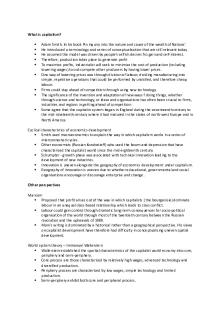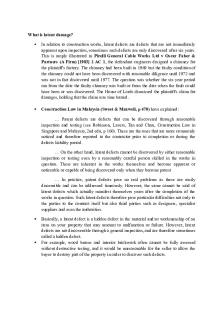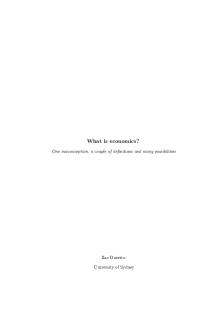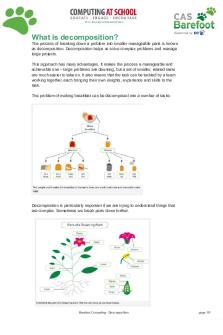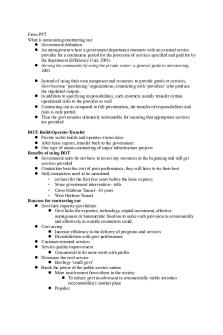What is capitalism - Lecture notes 2 PDF

| Title | What is capitalism - Lecture notes 2 |
|---|---|
| Course | A Global world |
| Institution | University of Southampton |
| Pages | 2 |
| File Size | 58.3 KB |
| File Type | |
| Total Downloads | 1 |
| Total Views | 134 |
Summary
1st Semester...
Description
What is capitalism?
Adam Smith. In his book ‘An inquiry into the nature and cause of the wealth of Nations’. He introduced a terminology and series of conceptualisation that are still relevant today. He assumed the model was driven by people’s selfish desires fro gain and self-interest. Therefore, production takes place to generate profit To maximise profits, industrialist will seek to minimise the cost of production (including lowering wages) to out-compete other producers by having lower prices. One way of lowering prices was through division of labour; dividing manufacturing into simple, repetitive operations that could be performed by unskilled, and therefore cheap labour. Firms could stay ahead of competition through using new technology. The significance of the invention and adaptation of new ways f doing things, whether through science and technology, or ideas and organisations has often been crucial to firms, industries and regions in getting ahead of competition Some agree that the capitalist system began in England during the seventeenth century to the mid-nineteenth century where it had matured in the states of north-west Europe and in North America
Cyclical characteristics of economics development Smith used macroeconomics to explain the way in which capitalism works in a series of interconnected cycles. Other economists (Russian Kondratieff) who used the boom and depression that have characterised the capitalist world since the mid-eighteenth century. Schumpter - growth phase was associated with technical innovation leading to the development of new industries. Innovation is uneven alongside the geography of economics development under capitalism. Geography of innovation is uneven due to whether educational, governmental and social organisations encourage or discourage enterprise and change. Other perspectives Marxism Proposed that profit arises out of the way in which capitalists ( the bourgeoisie) dominate labour in an unequal class-based relationship which leads to class conflict. Labour could gain control through dramatic long-term consequences for socio-political organisation of the world through most of the twentieth century between the Russian revolution and the upheavals of 1989. Marx’s writng is dominated by a historical rather than a geographical perspective. His views on capitalist development have therefore had difficulty in conceptualising uneven spatial development. World system theory – Immanuel Wallerstein Wallerstein established the spartial characteristics of the capitalist world ecnomy into core, periphery and semi-periphery. Core process are those characterised by relatively high wages, advanced technology and diversified production. Periphery process are characterised by low wages, simple technology and limited production. Semi-periphery exhibit both core and peripheral process.
Between 17th – 19th century regions were in the core (e.g. north-west Europe) or periphery (e.g. central Africa) Other reigions moved from semi-periphery to core (southern states of USA) or to periphery (the states emerging from the ruins of the ottoman/ Turkish empire). Walerstein’s theory has been very influential in explanations of the growth of globalisation but a little about the complexities of he social and economics networks.
The transition from feudalism to capitalism...
Similar Free PDFs

What is Theatre - NOTES 2
- 7 Pages

Is Capitalism Inevitable
- 5 Pages
Popular Institutions
- Tinajero National High School - Annex
- Politeknik Caltex Riau
- Yokohama City University
- SGT University
- University of Al-Qadisiyah
- Divine Word College of Vigan
- Techniek College Rotterdam
- Universidade de Santiago
- Universiti Teknologi MARA Cawangan Johor Kampus Pasir Gudang
- Poltekkes Kemenkes Yogyakarta
- Baguio City National High School
- Colegio san marcos
- preparatoria uno
- Centro de Bachillerato Tecnológico Industrial y de Servicios No. 107
- Dalian Maritime University
- Quang Trung Secondary School
- Colegio Tecnológico en Informática
- Corporación Regional de Educación Superior
- Grupo CEDVA
- Dar Al Uloom University
- Centro de Estudios Preuniversitarios de la Universidad Nacional de Ingeniería
- 上智大学
- Aakash International School, Nuna Majara
- San Felipe Neri Catholic School
- Kang Chiao International School - New Taipei City
- Misamis Occidental National High School
- Institución Educativa Escuela Normal Juan Ladrilleros
- Kolehiyo ng Pantukan
- Batanes State College
- Instituto Continental
- Sekolah Menengah Kejuruan Kesehatan Kaltara (Tarakan)
- Colegio de La Inmaculada Concepcion - Cebu
